We particularly welcome keen young players - but older players who are re-starting after a gap will be welcome too.
Table tennis is a sport for all and a sport for life.
A great all-weather activity to keep obesity at bay and stay young - even into one's 80's.
Reading is an exciting place for tt and has long been so - many stars have risen here.
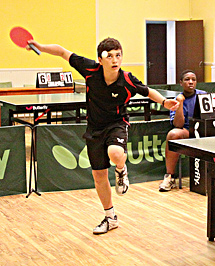 |
Reading has facilities for you to
- play for fun, exercise and perhaps self-improvement.
- (during the tt season) play other teams in matches, in the six divisions of the League.
- compete in tournaments for a rich variety of prizes.
"Where do I go to play?"
"I'm a beginner - where is best for me?"
"I used to play - but need to shake off some of the rust".
"What does it involve if I play in matches?"
"I suppose the rules have changed a lot in recent years?"
"How should I get hold of a bat?"
"What clothing does one need to wear?"
"Do women play in league matches?"
"What about children?"
"Where else can I look for information?"
"Who are the people to know in Reading table tennis?"
"What tournaments are run, and what standard of players do they cater for?"
"What age is the typical player in the league - and what ethnicity?"
Our planned Reading Table Tennis centre is not built yet, so you need to make contact with a club or other centre. There are 19 table tennis clubs in the Reading league - look on this Reading map to see which one is closest to you. (The map was put together by Didier Garçon, who also took some of the photographs on this page).
You should also look at the detailed notes on all the clubs on the present web site, for useful contact numbers etc.
A place where you can play without a club is Rivermead Leisure Centre, off Richfield Avenue in Caversham (0118 901 5000). They hire out tables during the day for £6.90 an hour.
(Incidentally, if you live or work beyond the Reading area, there are also leagues in Bracknell, Maidenhead, Oxford, Didcot, Newbury etc - see Google for contact details).
 |
If you are young enough to be at school, there may well be practice facilities at your school, with or without coaching. Or there is junior coaching at
Over-50s can play for fun and exercise at the Rivermead Leisure Centre off Richfield Avenue in Caversham (mentioned above in a different context). Sessions are on Monday and Friday mornings, from 0930 to 1230 odd, at a cost of around £3.50 a morning. They play doubles all the time, which in theory (and practice too) ensures a social spirit!
Beginners above school age but below 50 can try
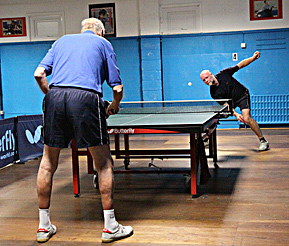 |
It sounds as if you will soon be ready to play in matches, so find a club on the map, and ring up the secretary for advice. All the clubs run teams in matches - the least is 1 team (BBC Club) and the most is Kingfisher with 11 teams. But please note that few clubs would have teams in all the divisions - so do look at the Clubs page to see which clubs have teams at the level you are likely to manage. (If you are still rusty at the start of the season, you will probably be invited to join a team in the bottom division, 6, to prove yourself. You can always be moved up to a higher division if you beat everyone there.)
If you want some professional help in sharpening up, then you could try the adult coaching on Friday evenings, that was recently announced at both Sonning Common and Kingfisher clubs.
Talking of the list of clubs, if you are hot stuff then you may be in a lot of demand - and could get a place in a higher team for a small club, than in one of the big clubs. Even clubs that are wedded to a particular firm (e.g. the BBC Club or Post Office) might accept a talented outsider, particularly if you befriend someone in that outfit to speak up for you. Look in the latest Newsletter for gossip on which clubs currently need an infusion of talent.
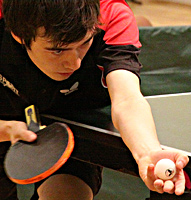 |
Playing in matches could involve turning out for your team once a week, every week of the season (between mid September and the end of March), with a break of a month around Christmas.
The reality could be less than that because normally your team will register more than the three players that play on any particular night. If your team has six players registered, then on average you will play once a fortnight instead of once a week. You can look on the Fixtures page of the web site for your particular division, to find out when your fixtures are. Once a fortnight on average your team will be playing at home - i.e. at your own club, on the same day of the week each time. 'Away' fixtures could be on any evening except, normally, Friday, Saturday or Sunday. Normally your team captain will give you enough notice of your selection, and you can give him notice of days when you will be unavailable. A full match usually takes about 3 hours, but can finish earlier and does not require everyone in the team to stay to the end.
After you have played in a match, the results will quickly find their way onto the Results pages of the RDTTA web site - and automatically your divisional table will be updated to take in that result, on the current tables page of the web site. At the same time your personal average (of sets won /sets played) will also be adjusted, and can be consulted on the Averages page for your division. And, four times in the season, the story of your team's matches including yours will be told in a Newsletter, accessible from the Newsletters page of the web site.
As for money, you will have to pay full club fees for a year plus £6.00 to the ETTA. The club fees vary widely from club to club, depending on whether it has to rent its own premises or rides on the back of some other organization. The lowest is likely to be around £30 a year. There are no additional per-session fees to pay for taking part in matches. Usually there are fee reductions for juniors, and sometimes senior citizens too.
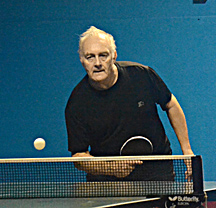 |
An ABC is not the right place for a proper description of the game, so let me refer you to Wikipedia on the subject.
In brief, though, the object of a game is now to reach 11 points before your opponent - not 21 points as it was before the year 2000. The ball is also a bit bigger than it was - and the laws on bats have changed. I used to have a bat that was green on both sides. Nowadays, one side of the bat has to be black and the other red. And these black and red rubber coverings have to be chosen off an up-to-date list specified by the ETTA.
Outside the League, it is sometimes possible to borrow a bat from the organizers - e.g. in junior coaching groups, and at the Rivermead Leisure Centre. Apart from that, you will be expected to bring your own bat - and most players won't be able to perform properly without their own bat. You can buy them ready made from some general place like John Lewis or Amazon. I would buy one costing about £15 to start with, to find out how you get on. If you buy the two rubbers and blade individually, you could spend £150 - and still be only guessing. An "all-round" bat is generally agreed as the best to start with. In other words, rather slow and not producing much spin. That may seem crazy advice, since people go into table tennis for the speed and fireworks. However, when you come to it you find that your opponent, if he is more experienced than you, will return any spin you can put on with ease - while if you have a spinny bat, you will lose every point to his super-spin services. An unresponsive bat is the best counter to spin from your opponent.
Varieties of rubber surface that you can buy include not only "reversed rubber" (the usual type, pimpled rubber glued facing in, with or without sponge) but "short pimples", "medium pimples", "long pimples" and "anti" (anti-spin, that is). The behaviours of these different surfaces, and of the different thicknesses of sponge to which they may be glued, make a complex subject to study. At present the ETTA web site has a page discussing them.
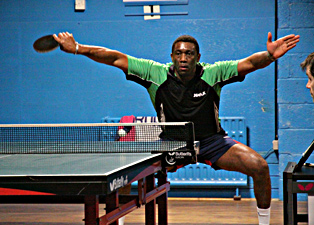 |
The photos on this page give some illustrations of normal wear. Dark shorts are normal - ladies could wear a short dark skirt as an option. Officially one is not supposed to wear a track suit in a match or tournament - but you sometimes find the central heating has packed up in the place where you are expected to play, and you could do yourself a mischief if you play on muscles that are too cold and stiff. So it is always worth taking a track suit in winter - and nobody will criticise you for keeping it on during a match. As for the top - "sports shirts" are specified, but many people wear Tee-shirts. The rules are now more relaxed than they were regarding the colours of tops. They still can't be white or anything like it (because that might make the ball invisible); and they can't carry a manufacturer's logo above a certain maximum size. But many very colourful designs are worn by internationals, and increasingly in the League. These are quite expensive - typically over £30. Many players, even top ones, still prefer dark muted colours. It's a matter of what kind of visual impact you want to make.
When you are simply practising or exercising - for instance at the Over-50s Club at Rivermead Leisure Centre - what you wear is even more up to you. You still need trainers of some sort - but any sort of dark clothing, including long trousers, is fine, depending on the air temperature.
Shoes are also important, in that we are usually required to wear 'non-marking plimsoles' in the sports halls where we play. One can buy special table tennis shoes - like squash shoes, with very thin rubber soles. These are said to anchor the player well and give good tactile feedback - but I find them quite tiring and painful to wear, and I prefer the cushioning of normal trainers. There are no restrictions on the colours of shoes. White socks tend to be worn.
 |
There are 19 women players in the various divisions of the league, using many different styles, and they are a valued part of the game. That is, however, only one woman player per club, on average. Table tennis is a sport where men's greater average strength, size and competitiveness are less decisive than in many other sports, including tennis. On the other hand, females often have family commitments that make it difficult for them to play regularly until late in the evening.
It is impressive but in my opinion also regrettable that the best junior girls rarely get to play in the league. The Farquhar sisters, Ayonija Sundarajaram, Megan Knowles, Maria Tsaptsinos - all tend to have been fast-tracked onto the national scene, without adding their sparkle to the feminine presence in the Reading league.
 |
Juniors (up to 18) play in the John Cunningham Youth League, early on Friday evenings at Bluecoats School. NB - see this excellent article on the Youth League by Adam McTiernan. They would have to reach quite a high standard to compete effectively in the main divisions. Nevertheless, with determination, talent and the remarkable level of coaching that is available, quite a few of them have soared amazingly and come to play effectively in the senior divisions - particularly in teams of
Coaching - in the shape of help from senior players - is available at several of the clubs; and more professional coaching groups at Kingfisher,
Coaching is also available at some primary schools - e.g. Caversham Primary.
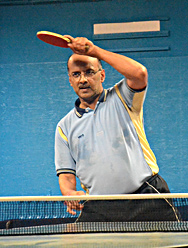 |
The Handbook is our league's bible - printed before the start of each season, and every member of the league gets a copy, through clubs and team captains. The handbook contains key information about rules, clubs and captains, and you can work out the dates of fixtures from its chart. Amongst much other information you can find lists of champions going back many years.
This official RDTTA web site, http://www.rdtta.co.uk is in many ways even more invaluable, in that it charts all the latest results in the league and is astonishingly up to date. Look at the menu column on the top left of this page - you can see the subjects offered for yourself. I would single out the lists of fixtures - down to the individual team; there are also pages for the results of the latest matches, which automatically update divisional tables of team performance, and individual averages as well. The web site also has a substantial section on the history of table tennis in Reading.
NB - please note an easy-to-remember alternative route to this ABC page: http://www.ReadingTableTennis.org.
Reading (and Henley) newspapers are an alternative source for the latest results - with League chairman Nigel Maltby sending in the reports - sometimes supplemented by Adam McTiernan on youth results, and other writers too.
 |
You can get many of the names from this very web site. First, the stars - look at the top names on the Rankings page (that you can get to from the menu above). And look at the Roll of Honour for details of past champions. Hari Gehlot - with his picture above on the right - has been a men's singles champion for many years in the past - and there's life in him yet, though Liam McTiernan and Daniel Moses seem to be carrying most things before them at present. Look in the Division One reports of recent newsletters to see more about the top players - and their photos too. On the national stage, Liam and his brother Daniel McTiernan have been doing rather well recently - with Megan Knowles and Maria Tsaptsinos on the girls' side.
Secondly, office holders in the RDTTA are listed on the Committee page - headed by Nigel Maltby, who combines the roles of chairman, secretary, publicity officer and much else. He, like other committee members, does these jobs for the love of it, while holding down a responsible day job at the same time. Other committee members include the registrations secretary and the fixtures secretaries for each of the divisions. Also the Junior Representative, Adam McTiernan, who is a whirlpool of energy, and the web site administrator, Nick Lean. And myself, Derek Wavell, the newsletter editor.
A third list is of club secretaries - whose names and phone numbers can be found under their club, listed on the Clubs page. And then you may need to know how to contact team captains of one or other team - their details are to be found in the latest Handbook.
Let me also mention Wendy Porter - the centre of coaching and much else at
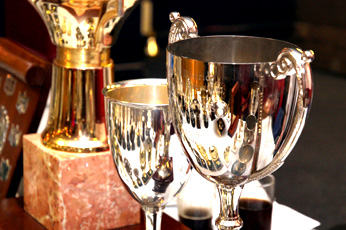 |
There are two tournaments for teams - the 5th/6th Divisions Knockout Cup and the Team Handicap Cup. Both of these are played over a number of weeks, using blank weeks in the league chart. Usually, the normal league teams enter for both of them - but in the case of the Team Handicap Cup, it is possible to put together a scratch team of players of mixed levels. Since each player is allocated his own handicap, this can give interesting results. Handicap contests are calculated on a 21-up basis, best of three.
Tournaments for individual players include the Berkshire Closed (November), the Individual Handicap (early January), the Reading Closed (February), Reading Masters (April) plus the IMPACT Challenge Shield team tournament, with finals also in April.
These tournaments all represent particular value because entry is free and there are plenty of glittering cups and trophies on offer. In addition, there is very often a photographer on hand, to record players in action for the next Newsletter.
Of these, the Individual Handicap tournament could be won by a player at any level. In 2012, the final was between a player of Div 6 against one of Div 1. As with the Team Handicap, games are 21-up, best of three. The Reading Closed offers chances to a lot of players too - because of specialist sub-tournaments: e.g. under-12 girls, mixed doubles, senior veterans etc etc. Many of these sub-tournaments have very few entries - so this is an excellent chance to pick up prizes on Presentations Day. The Berkshire Closed also has prizes for ladies, mixed doubles, and under-21. The Reading Masters is conducted between top players, by invitation - but includes both seniors and juniors. The IMPACT Challenge Shield is between just a few invited teams, mostly in the first division, so top quality is guaranteed (barring injuries).
 |
We have players of every age from 7 to about 85 - with bulges in the graph at ages below 20 and increasingly above 40 - 50 - 60. Once players are in the league they tend to stay there unless they move away - and the top playing age moves upwards with the increase in life expectancy. In fact, table tennis is just the sort of exercise that doctors approve of for prolonging life - since it does not place too much load on the heart or cause injuries, and is indoors. However, players often stop playing for a while in early adulthood, under pressures of work and settling down with a family - and don't come back into the game until later.
In terms of ethnicity, table tennis is a complete mix, very much the same mix as the general population. And within each club there is also a mix. So this is an excellent example of inter-community harmony. The only nation-specific club is the Polish Club - but they are happy to welcome other players of a different ancestry, and Polish individuals also join other clubs.
| Derek Wavell is on 0118 9476874 | Derek@readingtabletennis.org |
| Nigel Maltby is on 0118 9463191 | Nigel@readingtabletennis.org |